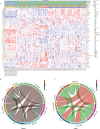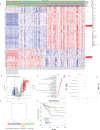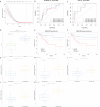Identification of prognostic gene expression signatures based on the tumor microenvironment characterization of gastric cancer
- PMID: 36032070
- PMCID: PMC9411533
- DOI: 10.3389/fimmu.2022.983632
Identification of prognostic gene expression signatures based on the tumor microenvironment characterization of gastric cancer
Abstract
Increasing evidence has elucidated that the tumor microenvironment (TME) shows a strong association with tumor progression and therapeutic outcome. We comprehensively estimated the TME infiltration patterns of 111 gastric cancer (GC) and 21 normal stomach mucosa samples based on bulk transcriptomic profiles based on which GC could be clustered as three subtypes, TME-Stromal, TME-Mix, and TME-Immune. The expression data of TME-relevant genes were utilized to build a GC prognostic model-GC_Score. Among the three GC TME subtypes, TME-Stomal displayed the worst prognosis and the highest GC_Score, while TME-Immune had the best prognosis and the lowest GC_Score. Connective tissue growth factor (CTGF), the highest weighted gene in the GC_Score, was found to be overexpressed in GC. In addition, CTGF exhibited a significant correlation with the abundance of fibroblasts. CTGF has the potential to induce transdifferentiation of peritumoral fibroblasts (PTFs) to cancer-associated fibroblasts (CAFs). Beyond characterizing TME subtypes associated with clinical outcomes, we correlated TME infiltration to molecular features and explored their functional relevance, which helps to get a better understanding of carcinogenesis and therapeutic response and provide novel strategies for tumor treatments.
Keywords: CTGF; fibroblasts; gastric cancer; prognostic model; tumor microenvironment.
Copyright © 2022 Sang, Dai, Yu, Chen, Fan, Liu, Li, Li, Wu, Hou, Yu, Feng, Zhu, Su, Li and Liu.
Conflict of interest statement
The authors declare that the research was conducted in the absence of any commercial or financial relationships that could be construed as a potential conflict of interest.
Figures






Similar articles
-
Single cell and bulk RNA sequencing identifies tumor microenvironment subtypes and chemoresistance-related IGF1+ cancer-associated fibroblast in gastric cancer.Biochim Biophys Acta Mol Basis Dis. 2024 Apr;1870(4):167123. doi: 10.1016/j.bbadis.2024.167123. Epub 2024 Mar 12. Biochim Biophys Acta Mol Basis Dis. 2024. PMID: 38484940
-
Characterization of gastric cancer-stimulated signaling pathways and function of CTGF in cancer-associated fibroblasts.Cell Commun Signal. 2024 Jan 2;22(1):8. doi: 10.1186/s12964-023-01396-7. Cell Commun Signal. 2024. PMID: 38167009 Free PMC article.
-
The cancer-associated fibroblast-related signature predicts prognosis and indicates immune microenvironment infiltration in gastric cancer.Front Immunol. 2022 Jul 29;13:951214. doi: 10.3389/fimmu.2022.951214. eCollection 2022. Front Immunol. 2022. PMID: 35967313 Free PMC article.
-
Roles of microRNAs in cancer associated fibroblasts of gastric cancer.Pathol Res Pract. 2017 Jul;213(7):730-736. doi: 10.1016/j.prp.2017.02.020. Epub 2017 Mar 8. Pathol Res Pract. 2017. PMID: 28554761 Review.
-
The role of cancer-associated fibroblasts in tumorigenesis of gastric cancer.Cell Death Dis. 2022 Oct 16;13(10):874. doi: 10.1038/s41419-022-05320-8. Cell Death Dis. 2022. PMID: 36244987 Free PMC article. Review.
Cited by
-
Integrated Multi-omics Data Analysis and In Vitro Validation Reveal the Crucial Role of Glycogen Metabolism in Gastric Cancer.J Cancer. 2025 Jan 13;16(4):1243-1263. doi: 10.7150/jca.104424. eCollection 2025. J Cancer. 2025. PMID: 39895799 Free PMC article.
-
CTGF, FN1, IL-6, THBS1, and WISP1 genes and PI3K-Akt signaling pathway as prognostic and therapeutic targets in gastric cancer identified by gene network modeling.Discov Oncol. 2024 Aug 12;15(1):344. doi: 10.1007/s12672-024-01225-4. Discov Oncol. 2024. PMID: 39133458 Free PMC article.
References
Publication types
MeSH terms
LinkOut - more resources
Full Text Sources
Medical
Miscellaneous

